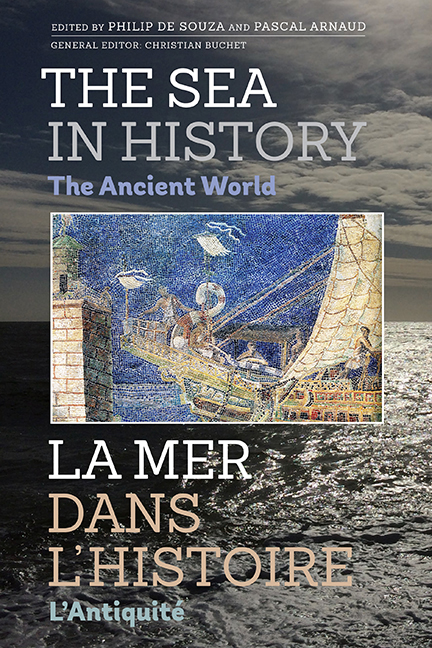Book contents
- Frontmatter
- Contents
- List of Illustrations
- List of Contributors
- Introduction générale et remerciements par Christian Buchet
- General introduction and acknowledgements
- Introduction (français)
- Introduction (English)
- La mer est le propre d'Homo sapiens
- PREHISTORICAL CASE STUDIES
- HISTORIAL CASE STUDIES: The Ancient Near East and Pharaonic Egypt
- Watercraft at the beginning of history: the case of third-millennium Southern Mesopotamia
- La navigation fluviale sur l'Euphrate au second millénaire av. J.-C.: usages, enjeux et communautés de pratiques
- The development of maritime exchange in the Bronze Age Eastern Mediterranean
- Development of maritime trade in the Egyptian world during the Late Age
- Les peuples de la mer
- Un événement nautique de la XXVIe dynastie: le voyage de la future divine adoratrice Nitocris de Saïs à Thèbes sous le règne de Psammétique Ier en 655 av. J.-C.
- HISTORICAL CASE STUDIES: The Mediterranean world
- HISTORICAL CASE STUDIES: The Indian Ocean and the Far East
- Conclusion (français)
- Conclusion (English)
- Conclusion générale par Christian Buchet
- General conclusion
- Comprendre le rôle de la mer dans L'histoire pour éclairer notre avenir
- Understanding the role the sea has played in our past in order to shed light on our future!
Watercraft at the beginning of history: the case of third-millennium Southern Mesopotamia
from HISTORIAL CASE STUDIES: The Ancient Near East and Pharaonic Egypt
Published online by Cambridge University Press: 20 April 2017
- Frontmatter
- Contents
- List of Illustrations
- List of Contributors
- Introduction générale et remerciements par Christian Buchet
- General introduction and acknowledgements
- Introduction (français)
- Introduction (English)
- La mer est le propre d'Homo sapiens
- PREHISTORICAL CASE STUDIES
- HISTORIAL CASE STUDIES: The Ancient Near East and Pharaonic Egypt
- Watercraft at the beginning of history: the case of third-millennium Southern Mesopotamia
- La navigation fluviale sur l'Euphrate au second millénaire av. J.-C.: usages, enjeux et communautés de pratiques
- The development of maritime exchange in the Bronze Age Eastern Mediterranean
- Development of maritime trade in the Egyptian world during the Late Age
- Les peuples de la mer
- Un événement nautique de la XXVIe dynastie: le voyage de la future divine adoratrice Nitocris de Saïs à Thèbes sous le règne de Psammétique Ier en 655 av. J.-C.
- HISTORICAL CASE STUDIES: The Mediterranean world
- HISTORICAL CASE STUDIES: The Indian Ocean and the Far East
- Conclusion (français)
- Conclusion (English)
- Conclusion générale par Christian Buchet
- General conclusion
- Comprendre le rôle de la mer dans L'histoire pour éclairer notre avenir
- Understanding the role the sea has played in our past in order to shed light on our future!
Summary
ABSTRACT.This contribution evaluates the importance of riverine and maritime navigation to the peoples of Southern Mesopotamia in the 3rd millennium BC. It shows that harbours, boats and mariners feature prominently in the surviving texts and artefacts. It also demonstrates that maritime trade was essential to the economies of the cities along the two major rivers, the Euphrates and the Tigris, which had close commercial ties with coastal communities around the Arabian Gulf, especially in the area of Bahrain and Oman, and the Indus Valley.
RÉSUMÉ.En s'appuyant notamment sur la représentation considérable des ports, bateaux et marins dans les artefacts et textes qui nous sont parvenus, cette contribution analyse l'importance de la navigation maritime et fluviale pour les peuples de la Basse-Mésopotamie au IIIème millénaire avant notre ère. Le rôle essentiel du commerce maritime pour l'économie des villes situées sur les bords des deux fleuves principaux – le Tigre et l'Euphrate – y est également démontré ainsi que les liens commerciaux qui se sont tissés avec les communautés côtières du golfe Persique, en particulier dans les régions du Bahreïn, d'Oman et de la vallée de l'Indus.
INTRODUCTION
Ancient Mesopotamia (from Greek ‘between rivers’), a region which nowadays comprises principally Iraq and north-eastern Syria, was shaped by the presence of the rivers Tigris and Euphrates. In addition, the southern alluvial plain which extended from Baghdad to the Arabian Gulf was dramatically influenced by an extended network of canals and by the proximity of the sea. Southern Mesopotamia is rightly characterized as the cradle of urban culture, as a land of cities. But most cities lie on a watercourse or even near the seashore, so that harbours, or at least mooring installations, were a structural part of the cities. Although the canal network developed for irrigation purposes, navigable canals and rivers were the principal routes for an intensive traffic of goods and people. Furthermore, foreign goods from the Arabian Gulf region could reach Mesopotamia only through maritime trade.
- Type
- Chapter
- Information
- The Sea in History - The Ancient World , pp. 127 - 137Publisher: Boydell & BrewerPrint publication year: 2017
- 2
- Cited by



